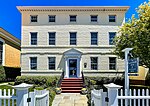Newport Steam Factory
Buildings and structures in Newport, Rhode IslandEnergy infrastructure on the National Register of Historic PlacesHistoric American Buildings Survey in Rhode IslandHistoric district contributing properties in Rhode IslandIndustrial buildings and structures on the National Register of Historic Places in Rhode Island ... and 5 more
Industrial buildings completed in 1831NRHP infobox with nocatNational Register of Historic Places in Newport, Rhode IslandNewport County, Rhode Island Registered Historic Place stubsUse mdy dates from August 2023

The Newport Steam Factory is an historic building at 449 Thames Street in Newport, Rhode Island. It is a 3+1⁄2-story stone structure, 120 feet (37 m) by 48 feet (15 m). It was built in 1831 by a group of local businessmen in an effort to boost the local economy, which had suffered since the British occupation during the American Revolutionary War. The building was used as a cotton mill until 1857. In 1892 it was purchased by the Newport Illuminating Company. It is now part of the International Yacht Restoration School. The building was listed on the National Register of Historic Places in 1972.
Excerpt from the Wikipedia article Newport Steam Factory (License: CC BY-SA 3.0, Authors, Images).Newport Steam Factory
Perry Mill Wharf, Newport
Geographical coordinates (GPS) Address Nearby Places Show on map
Geographical coordinates (GPS)
| Latitude | Longitude |
|---|---|
| N 41.484166666667 ° | E -71.316111111111 ° |
Address
Perry Mill Wharf 2
02840 Newport
Rhode Island, United States
Open on Google Maps








